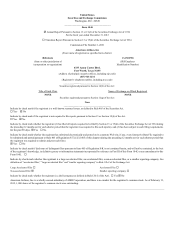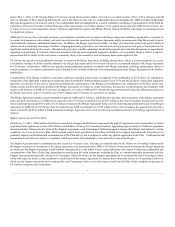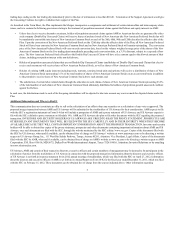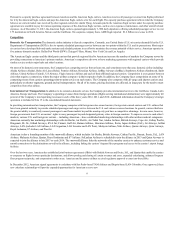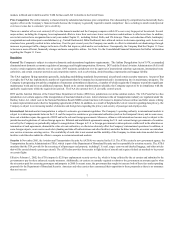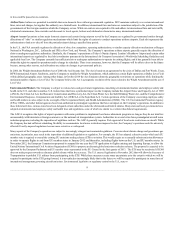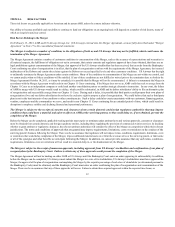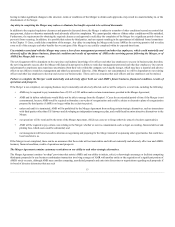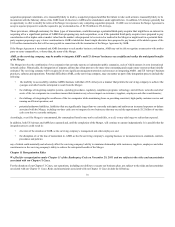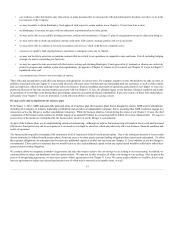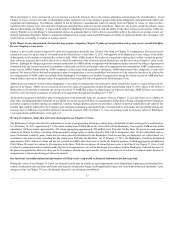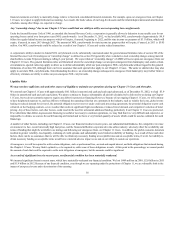American Airlines 2012 Annual Report Download - page 10
Download and view the complete annual report
Please find page 10 of the 2012 American Airlines annual report below. You can navigate through the pages in the report by either clicking on the pages listed below, or by using the keyword search tool below to find specific information within the annual report.
layers in fuel hedges on a systematic basis. Depending on movements in the price of fuel, the Company’s fuel hedging program can result in gains or losses on
its fuel hedges.
During 2012, 2011 and 2010, the Company’s fuel hedging program increased (decreased) the Company’s fuel expense by approximately $(4) million, $(297)
million and $124 million, respectively. As of January 2013, the Company had cash flow hedges covering approximately 21 percent of its estimated 2013 fuel
requirements. The consumption hedged for 2013 is capped at an average price of approximately $3.03 per gallon of jet fuel. Five percent of estimated 2013 fuel
requirements is hedged using call spreads with protection capped at an average price of approximately $3.37 per gallon of jet fuel. Sixteen percent of estimated
2013 fuel requirements is hedged using collars with an average floor price of approximately $2.39 per gallon of jet fuel. The cap and floor prices exclude taxes
and transportation costs. A deterioration of the Company’s financial position could negatively affect the Company’s ability to hedge fuel in the future. See the
Risk Factors under Item 1A for additional information regarding fuel.
Additional information regarding the Company’s fuel program is also included in Item 7(A) “Quantitative and Qualitative Disclosures about Market Risk,”
Item 7 “Management’s Discussion and Analysis of Financial Condition and Results of Operations” and in Note 8 to the consolidated financial statements.
Frequent Flyer Program
American established the AAdvantage ® frequent flyer program (AAdvantage) to develop passenger loyalty by offering awards to travelers for their continued
patronage. The Company believes that the AAdvantage program is one of its competitive strengths. AAdvantage benefits from a growing base of approximately
72 million members with desirable demographics who have demonstrated a strong willingness to collect AAdvantage miles over other loyalty program
incentives and are generally disposed to adjusting their purchasing behavior in order to earn additional AAdvantage miles. AAdvantage members earn mileage
credits by flying on American, the American Eagle carriers, and the third party regional airlines or by using services of other participants in the AAdvantage
program. Mileage credits can be redeemed for free, discounted or upgraded travel on American, the American Eagle carriers or other participating airlines, or
for other awards. Once a member accrues sufficient mileage for an award, the member may book award travel. Most travel awards are subject to capacity
controlled seating. A member’s mileage credit does not expire as long as that member has any type of qualifying activity at least once every 18 months.
American sells mileage credits and related services to other participants in the AAdvantage program. There are over 1,000 program participants, including a
leading credit card issuer, hotels, car rental companies and other products and services companies in the AAdvantage program. The Company believes that
program participants benefit from the sustained purchasing behavior of AAdvantage members, which translates into a recurring stream of revenues for
AAdvantage. Under its agreements with AAdvantage members and program participants, the Company reserves the right to change the AAdvantage program
at any time without notice, and may end the program with six months notice. As of December 31, 2012, AAdvantage had approximately 72 million total
members, and 609 billion outstanding award miles. During 2012, AAdvantage issued approximately 209 billion miles, of which approximately 66% were
sold to program participants. See “Critical Accounting Policies and Estimates” under Item 7 for more information on AAdvantage.
Cargo
American Airlines Cargo, a division of American, provides over 100 million pounds of weekly cargo lift capacity to major cities in the United States, Europe,
Canada, Mexico, the Caribbean, Latin America and Asia. American’s cargo network is one of the largest air cargo networks in the world, with facilities and
interline connections available across the globe. During 2012, American Airlines Cargo accounted for approximately 2.7 percent of the Company’s operating
revenues by generating $669 million in freight and mail revenue, a decrease of 4.8 percent versus 2011.
Other revenues
Other revenues, which approximate 10.1 percent of total revenues, includes revenue from the marketing services related to the sale of mileage credits in the
AAdvantage program as discussed above, membership fees and related revenue from the Company’s Admirals Club operations, and other miscellaneous
service revenue, including administrative service charges and baggage handling fees.
Other Matters
Seasonality and Other Factors The Company’s results of operations for any interim period are not necessarily indicative of those for the entire year since
the air transportation business is subject to seasonal fluctuations. Higher demand for air travel has traditionally resulted in more favorable operating and
financial results in the second and third quarters of the year than in the first and fourth quarters. Fears of terrorism or war, fare initiatives, fluctuations in fuel
prices, labor actions, weather, natural disasters, outbreaks of disease, and other factors could impact this seasonal pattern. Unaudited quarterly financial data
for the two-year
10

